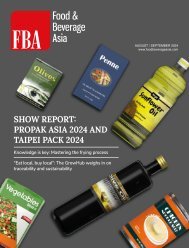Dental Asia March/April 2019
For more than two decades, Dental Asia is the premium journal in linking dental innovators and manufacturers to its rightful audience. We devote ourselves in showcasing the latest dental technology and share evidence-based clinical philosophies to serve as an educational platform to dental professionals. Our combined portfolio of print and digital media also allows us to reach a wider market and secure our position as the leading dental media in the Asia Pacific region while facilitating global interactions among our readers.
For more than two decades, Dental Asia is the premium journal in linking dental innovators
and manufacturers to its rightful audience. We devote ourselves in showcasing the latest dental technology and share evidence-based clinical philosophies to serve as an educational platform to dental professionals. Our combined portfolio of print and digital media also allows us to reach a wider market and secure our position as the leading dental media in the Asia Pacific region while facilitating global interactions among our readers.
Create successful ePaper yourself
Turn your PDF publications into a flip-book with our unique Google optimized e-Paper software.
Word of Mouth<br />
by<br />
Dr. Christoper Ho<br />
This issue we look into some products that Dr. Christopher Ho considers very useful in making his practice efficient.<br />
Dentistry is a constant battle with tongues, fluids and bacteria, not to mention, practitioners have to<br />
deal with the patient’s psyche and staff as well. Finding those products that make a practitioner’s life<br />
a little bit easier can hopefully bring a smile to all our faces by the end of the day.<br />
Biogide compressed (Geistlich)<br />
A new resorbable membrane has been developed by Geistlich for tissue regeneration. It is<br />
a twin to Biogide in that it consists of porcine collagen with the same barrier function and<br />
resorption time. However, the differences are in the handling and application. It possesses<br />
a smoother surface, a firmer feel and it is easier to cut. For those that prefer a sturdier<br />
membrane, this may be preferred and in particular may suit those wanting to carry out<br />
larger regenerations and tacking of the membranes. It is all about clinician preference and<br />
Geistlich has released this membrane to cater for those that prefer a slightly stiffer membrane.<br />
myQuickmat Forte Kit (SDI)<br />
There is a new sectional matrix system on the market available from SDI called myQuickmat<br />
and as an alternative to the current systems on the market it has some advantages for use.<br />
The rings provide strong tooth separation in order to create excellent contact points in the<br />
restoration of Class II restorations. It is autoclavable and the plastic tines ensure a perfect<br />
adaptation of the matrix to palatine/lingual and buccal walls, reducing the need for finishing<br />
steps and therefore saving time. What is unique is that the tines are replaceable so that this<br />
ensures durability to the system. Often with other systems, the plastic tines pick up bond and<br />
also degrade reducing the life of these systems. With the plastic tines being interchangeable, this<br />
should ensure improved longevity of the rings, by just changing the tines. In addition, the metal<br />
rings can be activated to increase the active separation if needed when they loosen over the time.<br />
Moreover, the system comes with LumiContrast sectional matrices which are dark-blue matrices<br />
that increase contrast and reduce glare effect, especially while using loupes or microscopes.<br />
Wand Milestone Scientific<br />
“I didn’t feel a thing” is a nice compliment that patients give when patients receive an injection<br />
and often commented upon receiving injections from this computer assisted system for local<br />
anaesthesia. The machine enables users to control the flow rate and more importantly the<br />
pressure of the anaesthetic fluid being injected. It is normally the pressure of the anaesthetic<br />
being injected too quickly that causes discomfort with injections. Hence, even the dreaded<br />
palatal injections are often a breeze and virtually painless. This technique also allows the use<br />
of intraligamentary techniques for single tooth anaesthesia as well as techniques such as<br />
the Anterior Middle Superior Alveolar (AMSA) injection technique which can achieve pulpal<br />
anaesthesia from the maxillary central incisor to the second premolar - including the palatal<br />
tissue from a single injection in the palate between the premolars.<br />
22<br />
DENTAL ASIA MARCH / APRIL <strong>2019</strong>


















